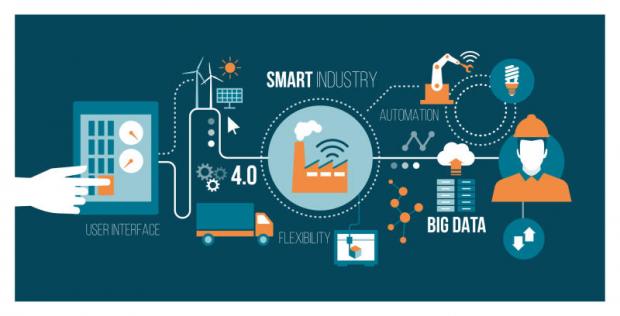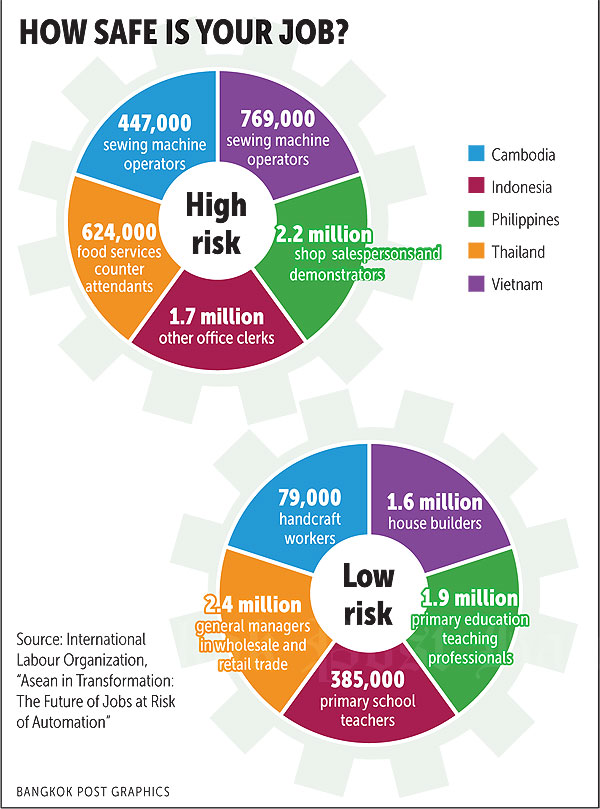
Smart manufacturing does not always involve robots replacing people. Instead, robots should be viewed as enablers instead of disruptors, with productivity and efficiency enhanced by automation, artificial intelligence (AI) and the Internet of Things (IoT).
More and more manufacturers are adapting to this reality in order to sustain their competitiveness. Nevertheless, it is a fact that people are still losing labour-intensive and time-consuming jobs to machines -- in services as well as manufacturing.
Deutsche Bank chief executive John Cryan has said a "big number" of his staff will eventually lose their jobs to robots and other forms of technology. "It doesn't matter if we as a bank will participate in these changes or not, it is going to happen," he said at the "Banking in Transition" conference in Frankfurt last month.
The World Economic Forum forecast in its 2016 report, The Future of Jobs, that automation will lead to a net loss of over 5 million jobs in 15 major developed and emerging economies by 2020. These countries include Australia, China, France, Germany, India, Italy, Japan, the United Kingdom and the United States.
PricewaterhouseCoopers says as many as 38% of jobs in the US could be at potential risk of automation by the early 2030s, along with 35% in Germany, 30% in the UK and 21% in Japan.
Closer to home, the International Labour Organization (ILO) said in its 2016 report, Asean in Transformation, that more than half of the workers in five Southeast Asian countries were at high risk of losing jobs to automation, with the garment industry the most vulnerable. Other high-risk sectors include automobiles and parts, electrical and electronic goods, business process outsourcing and retailing.
All told, 137 million workers or 56% of the salaried workforce from Cambodia, Indonesia, the Philippines, Thailand and Vietnam are at a high risk of losing their jobs in the next 20 years, the study showed.
The region's textile, clothing and footwear sector employs 9 million people, mostly in Indonesia, Vietnam and Cambodia, and the auto industry employs about 800,000, mostly in Indonesia and Thailand. The ILO said technologies including 3D printing, wearable technology, nanotechnology and robotic automation could disrupt the sector as "robots are becoming better at assembly, cheaper and increasingly able to collaborate with people".
Nonetheless, there are ways for robots and humans to coexist in a workplace.
"If you look at most automation, it comes down to man-machine combinations," Reid Hoffman, the cofounder of LinkedIn, said in a discussion held by the McKinsey Global Institute in 2014. He recalled that when he visited a plant in Shenzhen operated by the Chinese tech company Huawei, he expected to see a complete line of robots but what he saw was different.
"I was expecting, as a Silicon Valley technologist, that it would be a complete line of robots. The whole thing would be automated because that would obviously be the thing to do," he said.
"Roughly 60% of it was automated and 40% of it was still people. And it's all a question of choice. You say, 'Is that just because of low cost?' No, no. These are actually high-pay, high-skill jobs."
"Adaptability is key," said Mr Hoffman, noting that for a company like Huawei, setting up an all-machine line would require a huge amount of retooling to shift from one line to another, whereas people are much easier to move. Therefore, a part-machine, part-human factory makes more sense.
And while Jack Ma, co-founder of Alibaba, believes that computing and AI are essential for business and called for traditional industries to stop complaining about the internet's impact, he still believes that "machines should only do what humans cannot".
"Only in this way can we have the opportunities to keep machines as working partners with humans, rather than as replacements," he told an entrepreneurship conference in Zhengzhou in April.

HOW IT WORKS
To smartly manufacture anything involves digitising your assets, collecting information from sensors, and then making use of the data to efficiently create a product that people actually want.
"The technique is the marrying of digitisation and IoT within a factory. For example, some of the key points for industry 4.0 are the ability to monitor equipment and the ability to predict failure of the equipment," Bharath Ramesh, head of product management functions for the Edge Infrastructure Systems Group at Hewlett Packard Enterprise, said at the 13th edition of Asia IoT Business Platform (AIBP) held in Bangkok in July.
Unlike earlier technology, smart manufacturing is "fundamentally transforming how manufacturing companies compete", according to John Clemons, director of manufacturing IT for Maverick Technologies.
"With smart manufacturing strategies, companies gain powerful capabilities to drive competitive advantage. Factories cut costs, reduce time-to-delivery and increase order accuracy," he wrote in an article for the Forbes Technology Council.
In order to start a digital transformation journey, a manufacturer must have a proper assessment of where it is digitally in terms of machines and staff, says Alfee Lee, head of digital solutions at Fujitsu.
"With the right assignment, at least we can plan for the future because we have to know what the current situation is before transforming from IT to OT," he said.
IT/OT convergence involves the integration of information technology (IT) systems centred on data with operational technology (OT) systems used to monitor events, processes and devices and adjust industrial operations.
The first connection that has to be managed is the one between human staff and machines. Everybody in the plant should be able to wirelessly connect to the machines they are authorised to use, and the central command should be able to connect to all of the staff individually.
"A connected central operation allow managers to know where everybody is at all times which allows for greater control, and with digital inspection, managers can know the state of each machine at all times which allows for instant management," Mr Lee said.
Fujitsu's Smart Plant Solutions include digitised inspection systems that allow for voice, video and web conference inspection and updating of data in real time within any facility. Expertise can be acquired remotely from anywhere, leading to increased collaboration and more effective maintenance.
Most manufacturing plants are already using IT, sensors, intelligent motors, computerised controls and production management software to manage specific, separate stages of a process. Smart manufacturing solutions integrate all sections to enable data sharing throughout the plant, Mr Lee explained.
It is also possible to manage contractors' work performance by monitoring, via a supervisor's tablet, the whereabouts of the contractor through real-time location tracking. Safety clearance and permissions will be much easier, and a supervisor can more easily match work orders and skills or people to machines. As well, safety units can respond more effectively to accidents when they occur.
IT-OT integration can also be used to build a big data analysis platform, monitor the status of the production line in real time, and display important performance indicators that will improve preventive maintenance and result in fewer breakdowns, thus reducing the need for large and costly spare-parts inventories.
Put all the solutions together and supervisors can run entire plants at variable speeds with real-time flexibility. They can also conserve energy via the use of smart grids to schedule energy-intensive activities during low-demand periods and slow production at peak energy demand times.

FUTURE OF MANUFACTURING
What we now call the IoT has become transformational because it is the main engine behind "smart" anything, from homes to cities to factories. It puts the internet to work in ways few could have imagined a decade or two ago, says Mr Ramesh of HPE.
He uses Uber as an example. In the 1990s, we were told that the internet was potentially dangerous -- if you talked to strangers online, you probably shouldn't meet them. Yet here we are in 2017, summoning a stranger via the internet to come pick us up at our home.
Without IoT, Uber would not have happened, as the concept of ride sharing itself was nothing new. "There was an Uber way before Uber," co-founder Travis Kalanick said in a TED Talk in 2016, referring to the Jitney, a ride-sharing service invented by LP Draper in 1914.
The business model existed, in other words, and all Uber did differently was apply digital technology. With GPS, customers know where the driver is, and the application offers other information including the driver's name and how other passengers have rated him or her. Without this information, you probably would think twice before entering a stranger's car, Mr Ramesh said.
According to the latest annual survey by Asia IoT Business Platform of 400 Asean organisations, 73.3% say they are now in the process of exploring or implementing IoT applications. That is up from 50% last year.
The 2017 Asean Enterprise IoT Survey also revealed that organisations in Asean believe IoT can help them to improve productivity (76.3%), reduce long-term operational costs (69.7%), and improve customer relationships (66.1%).
However, it found that only 7% of Asean business leaders reported benefitting from any IoT implementation, citing costs, incompatibility with current systems, and complexity.
Hidenori Furukawa, an advisory partner at KPMG Thailand, advises companies to first develop a richer understanding of the benefits of IoT through experimenting and learning solutions, and once the benefits are realised, the business can then move to larger-scale transformations.
"Although IoT implementation may seem costly in the short term, it should be viewed as an investment for the future," he said. "We recommend that businesses think big, start small."
There are, however, people who are thinking about the next step of tailored manufacturing already. Sujeet Chand, chief technology officer at Rockwell Automation, expects that in a decade or sooner, global manufacturing will look nothing like it does today.
He told Time magazine that smart manufacturing will replace lean manufacturing as the main strategy because smart manufacturing will increase the flexibility of plants, lower the cost of products and improve environmental sustainability. It will also enable the development of innovative products using next-generation materials.
The resulting shift, he says, will do for manufacturing what eBay and Amazon have done to the retailing world. He believes that flexible factories and IT-optimised supply chains will change processes to allow manufacturers to customise products to individual needs. Customers will be able to directly tell a factory what to make and what features they want, right down to the size of your shoe.
And that's just the beginning, said Vivek Wadhwa, a distinguished fellow at Carnegie Mellon University's College of Engineering in Silicon Valley, when the McKinsey Global Institute asked him to look into the future.
"So what we're going to see is automation … and give it 15 years, and now we have the robots going out on strike saying, 'Stop the 3D printers, they're taking our jobs away'," he said.
THREE PHASES
Smart manufacturing technologies will drive transformations in three rapid, progressive phases:
Phase one: Integration of all manufacturing data throughout individual plants and across enterprises will facilitate significant, immediate improvements in costs, safety and environmental impacts.
Phase two: This data, paired with advanced computer simulations and modelling, will create robust "manufacturing intelligence" that will enable variable-speed, flexible manufacturing, optimal production rates and faster product customisation.
Phase three: As manufacturing intelligence grows, it will inspire innovations in processes and products that comprise smart manufacturing's promise — a major market disruption such as a $3,000 automobile or a $300 personal computer.
Source: Rockwell Automation and University of California